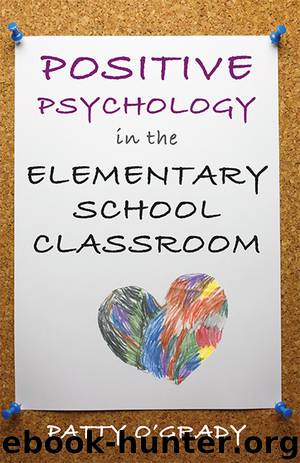Positive Psychology in the Elementary School Classroom by Patty O'Grady

Author:Patty O'Grady
Language: eng
Format: epub
Publisher: W. W. Norton & Company
Summary and Conclusion
The positive psychology teaching taxonomy benchmark of strength teaches the four pillars of strengths learning: (1) identify and recognize strengths in self and others, (2) build a signature strength, core strength, and challenge strength, (3) practice and use strengths to accomplish goals, and (4) encourage others to use strengths to accomplish their goals. Teachers use the methods and techniques of positive psychology to ensure that children can moderate emotions with their strengths. Children identify, build, extend, and apply empathy, generosity, courage, grit, patience, optimism, and good cheer. They learn to use their signature strengths as a framework for all learning and living. In the positive psychology classroom, children learn to read, dance, meditate, self-soothe, and play games in order to increase the strengths that bring accomplishment.
Children learn that they do not always get what they want or want what they get. They understand life is not always easy and it can be messy, hurtful, and discouraging. Moreover, they learn to use their signature strengths to make the best of it and to look toward a better day tomorrow. Children learn that they will stumble and fall, and they learn to pick themselves up and begin again with a deep breath, a quick tap dance, or an encouraging self-talk. When they fall, they quickly forgive themselves, reappraise the situation, decide their best is always good enough, and reconsider their options. The pursuit of perfection does not paralyze them.
Children learn to show empathy toward those who hurt them by saying, “I understand”; they show generosity toward those who help them by saying, “thank you.” They show courage when befriending children different from them and they remain determined to do their best. They are optimistic that they can pass a difficult test if they study; they learn to use their grit to try, to fail, and to try again. They use patient research to seek out new books to read and new puzzles to solve.
Children may need good grades to accomplish their goals; however, they need more than academic achievement for success. They also need to be highly accomplished in the art and science of emotional strength. One cannot substitute for the other and children must pursue them in equal measure. To succeed children need to develop “clear-eyed energy and motivation, and clearly understood strengths.”141
Children remind themselves that their lives are full of good and that most of the time they are sufficiently engaged that they lose track of time so the day flies by. “I can’t believe how fast the day went and how much I learned.” No matter what children do, or how they act, the teacher only uses the language of strength and never fails to suggest or correct actions related to the strength. He or she never criticizes or chastises the students. Instead, the teacher waves a magic wand to cue them to use their strength. Positive psychology significantly advances the efforts to promote emotional strength as essential to well-being. Close your eyes—shut the negative classroom door. Open them—walk through the positive psychology classroom door.
Download
This site does not store any files on its server. We only index and link to content provided by other sites. Please contact the content providers to delete copyright contents if any and email us, we'll remove relevant links or contents immediately.
| Administration | Assessment |
| Educational Psychology | Experimental Methods |
| History | Language Experience Approach |
| Philosophy & Social Aspects | Reform & Policy |
| Research |
The Art of Coaching Workbook by Elena Aguilar(50885)
Trainspotting by Irvine Welsh(21493)
Twilight of the Idols With the Antichrist and Ecce Homo by Friedrich Nietzsche(18482)
Fangirl by Rainbow Rowell(9076)
Periodization Training for Sports by Tudor Bompa(8148)
Change Your Questions, Change Your Life by Marilee Adams(7617)
This Is How You Lose Her by Junot Diaz(6764)
Asking the Right Questions: A Guide to Critical Thinking by M. Neil Browne & Stuart M. Keeley(5609)
Grit by Angela Duckworth(5500)
Red Sparrow by Jason Matthews(5374)
Paper Towns by Green John(5072)
Room 212 by Kate Stewart(5018)
Ken Follett - World without end by Ken Follett(4625)
Housekeeping by Marilynne Robinson(4310)
The Sports Rules Book by Human Kinetics(4276)
Double Down (Diary of a Wimpy Kid Book 11) by Jeff Kinney(4189)
Papillon (English) by Henri Charrière(4181)
The Motorcycle Diaries by Ernesto Che Guevara(3995)
Exercise Technique Manual for Resistance Training by National Strength & Conditioning Association(3941)
